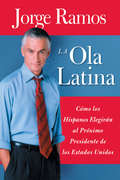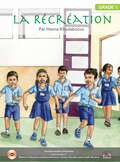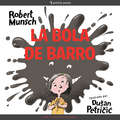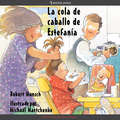- Table View
- List View
La Mariposa (Into Reading, Trade Book #1)
by Francisco Jiménez Simón SilvaNIMAC-sourced textbook. In his first year of school, Francisco understands little of what his teacher says. But he is drawn to the silent, slow-moving caterpillar in the jar next to his desk. He knows caterpillars turn into butterflies, but just how do they do it? To find out, he studies the words in a butterfly book so many times that he can close his eyes and see the black letters, but he still can't understand their meaning. Illustrated with paintings as deep and rich as the wings of a butterfly, this honest, unsentimental account of a schoolchild's struggle to learn language reveals that our imaginations powerfully sustain us. La Mariposa makes a subtle plea for tolerance in our homes, our communities, and in our schools.
La Mariposa (¡Arriba la Lectura!, Trade Book #1)
by Francisco Jiménez Simón SilvaNIMAC-sourced textbook
La Odisea: Mito Griego (Reader's Theater Folktales, Myths And Legends Ser.)
by Jeannette SandersonNIMAC-sourced textbook
La Ola Latina
by Jorge RamosEn La Ola Latina el reconocido escritor y galardonado periodista Jorge Ramos explora el impresionante crecimiento de los hispanos y analiza cómo los latinos estántransformando la economía, la cultura y la política de Estados Unidos. En los últimos años la población latina en Estados Unidos ha crecido de una manera extraordinaria, dándoles a los hispanos la posibilidad de influir de forma muy significativa en las elecciones y en la vida política del país. En las elecciones del 2004, por ejemplo, se espera que el voto latino sea un factor determinante en por lo menos diez estados que tienen más del 10 por ciento de población hispana, incluyendo a Nueva York, Texas, California, Florida e Illinois. Es imposible ignorar una influencia tan grande y un voto tan importante. Para muchos es difícil comprender que el cambio más dramático que está viviendo este país no tiene nada que ver con la guerra contra el terrorismo o con la economía; tiene que ver, simplemente, con la revolución demográfica impulsada por los latinos. Es la ola latina. En el 2002 los latinos se convirtieron, oficialmente, en el grupo minoritario más grande de Estados Unidos, superando los 38 millones de habitantes. La noticia sorprendió porque no se esperaba que esto ocurriera hasta, al menos, una década después. Este tipo de crecimiento presagia que los latinos tendrán un papel fundamental en el futuro de Estados Unidos y, particularmente, en la política. Todo tendrá que pasar por el filtro de los hispanos porque Estados Unidos se está latinizando. Si las tendencias no cambian, habrá más latinos que blancos no hispanos en el país el próximo siglo. Los latinos -- tanto los inmigrantes recién llegados como aquellos que nacieron en Estados Unidos -- están cambiando para siempre el tejido social y cultural de este país. En La Ola Latina , Ramos afirma que será aquel partido político que mejor comprenda los deseos y las necesidades de los hispanos que viven en este país, el que eventualmente ganará las próximas elecciones.
La Récréation class 1 - MIE
by Par Hanna Khodabocus"La Récréation" est un livre géant conçu pour stimuler l'éveil à la littératie chez les élèves de première année. L'histoire se déroule pendant la récréation à l'école, où Sara et le narrateur jouent à cache-cache avec leurs amis, tandis que d'autres enfants participent à des courses, jouent au ballon, à la marelle ou simplement discutent. L'atmosphère dynamique et diversifiée de la récréation est illustrée à travers différentes activités des enfants. Cependant, l'ambiance ludique est brièvement interrompue lorsque Robin se blesse, soulignant l'importance de la prudence pendant le jeu. La cloche sonne, annonçant la fin de la récréation et le retour en classe. Ce livre vise à susciter l'interaction des élèves en les incitant à partager leurs expériences pendant la récréation, tout en développant leur compréhension du vocabulaire et en encourageant des activités créatives basées sur le thème de la récréation.
La Serpiente Arcoíris: Cuento aborigen australiano (¡Arriba la Lectura!, Level R #4)
by Chris Sarandis Bronwyn BancroftNIMAC-sourced textbook
La Sra. Higgs comienza la escuela (¡Arriba la Lectura!, Level J #27)
by Carmel Reilly Beth NorlingLa Sra. Higgs es la maestra nueva, ¡y hoy es su primer día en la escuela! Ella quiere que todo le salga bien, pero, ¿y si algo sale mal? NIMAC-sourced textbook
La actuación sorpresa de Zac (¡Arriba la Lectura!, Level L #59)
by Cameron Macintosh Tom JellettNIMAC-sourced textbook. Todos en la familia de Zac son artistas de circo, ¡menos Zac! La familia está ocupada ensayando su presentación del sábado por la noche. Pero el día antes de la gran función, algo sale mal. ¿Podrán Zack y su loro, Plumón, salvar la situación?
La alfombra del príncipe (¡Arriba la Lectura!, Level L #1)
by Katya Krenina Jacqueline GreeneUnos ladrones capturan al príncipe Jabib cuando sale a montar a caballo. El príncipe astuto ofrece fabricar alfombras para que los ladrones las vendan. ¿Logrará escapar de la cueva con su habilidad para tejer alfombras? NIMAC-sourced textbook
La asombrosa vida de las mariposas monarca (¡Arriba la Lectura!, Big Book Module #7)
by Ángela CalderónNIMAC-sourced textbook
La aventura de Luca en Florencia (¡Arriba la Lectura!, Level T #42)
by Cameron Macintosh Alessandro BaldanziEl hermano mayor de Luca, Renzo, se ha ido de la granja y se ha mudado a Florencia para trabajar como ayudante de un artista. Mientras Luca aprende carpintería con su padre, se pregunta cómo será vivir en el taller de una artista en la gran ciudad. NIMAC-sourced textbook
La bella durmiente: Un cuento moderno (¡Arriba la Lectura!, Level L #12)
by Jill McDougall Dori BerkovicSe organiza una fiesta por el nacimiento de la princesa Carla. Las hadas Maga y Brisa y su amigo, el duende Colibrí, van a concederle tres deseos a la niña. Pero nadie ha invitado al Hada Malvada y eso la tiene de muy mal humor. NIMAC-sourced textbook
La bola de barro
by Robert Munsch Dusan PetricicCada vez que Jule Ann sale al jardín, una bola de barro le cae encima y la llena de barro. Ni bien se limpia completamente, la bola de barro la ataca de nuevo. Pero finalmente Jule Ann logra vencerla con su alegre ingenio y dos barras de apestoso jabón amarillo.
La burbuja feroz (¡Arriba la Lectura!, Trade Book #12)
by Adam Rubin Daniel SalmieriNIMAC-sourced textbook
La cabalgata nocturna de Sybil Ludington (¡Arriba la Lectura!, Level P #70)
by James Watling Marlene Pérez Joe LemonnierMuchos valientes trabajaron para liberarnos de los británicos. Entre ellos había una niña llamada Sybil. Lee sobre su cabalgata nocturna. NIMAC-sourced textbook
La cabeza bien alta, Molly Lou Melon (¡Arriba la Lectura!, Trade Book #5)
by David Catrow Patty LovellNIMAC-sourced textbook
La caja de Pandora
by Lori O'Dea Kathryn L. O'Dell Niki LeonidouPandora gets a box she shouldn't open, but she is curious. Read to find out if she opens the box and what is inside.
La caja del cumpleaños (¡Arriba la Lectura!, Level S #29)
by Mark Weber Haydn MiddletonA Nadira Bakshi siempre le ha encantado cumplir años. Conserva todos los recuerdos de sus cumpleaños pasados en una caja bellamente decorada. ¿Por qué cuando su undécimo cumpleaños está a la vuelta de la esquina le tiene terror a cumplir un año más? Es por la caja del cumpleaños. Nadira y su amiga Alexis comienzan a encontrar cosas extrañas dentro, ¡cosas que no debían estar allí! ¿Descubrirán el secreto de la caja del cumpleaños antes de que sea demasiado tarde? NIMAC-sourced textbook
La carrera de patinetas (¡Arriba la Lectura!, Level J #30)
by Lyn Stone Jackie TideyNIMAC-sourced textbook. ¡Una carrera de patinetas en Greenway Park! ¿Quién ganará? ¿Será Ben, será Nick o seré yo?
La cola de caballo de Estefanía
by Robert Munsch Michael MartchenkoNinguno de los compañeros de clase de Estefanía se recoge el pelo en una cola de caballo. Entonces Estefanía decide hacerse una. Los demás niños le gritan: "¡Qué fea! Qué fea!". Pero a Estefanía no le importa. Cuando todas las niñas se copian de ella, Estefanía decide probar un peinado nuevo. En el estilo típico de Munsch, cada una de las colas de caballo de Estefanía es más disparatada que la anterior, y la lista de copiones sigue creciendo . . .
La colcha de retazos de la naturaleza: Entendamos los hábitats (¡Arriba la Lectura!, Read Aloud Module 9 #1)
by Mary Miché Consie PowellNIMAC-sourced textbook
La era de los descubrimientos (¡Arriba la Lectura!, Level W #79)
by Heather HammondsNIMAC-sourced textbook




